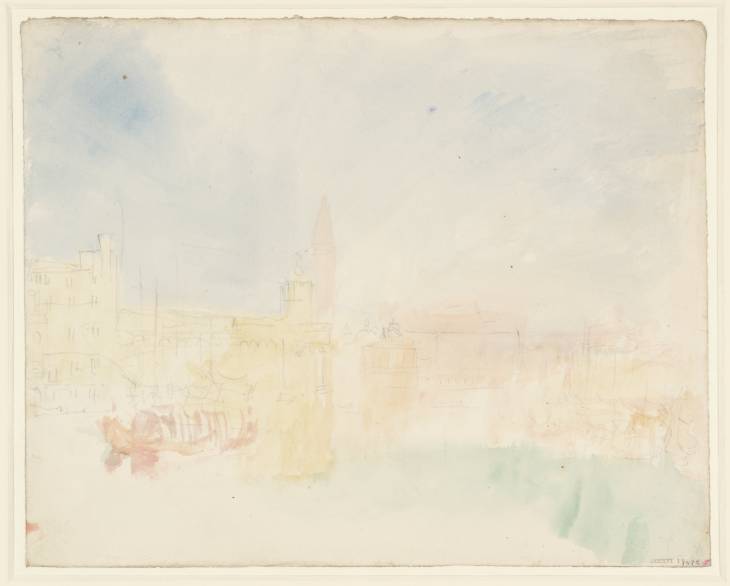Joseph Mallord William Turner The Dogana, Venice, with the Campanile of San Marco (St Mark's) Beyond, from the Canale della Giudecca 1840
Joseph Mallord William Turner,
The Dogana, Venice, with the Campanile of San Marco (St Mark's) Beyond, from the Canale della Giudecca
1840
Joseph Mallord William Turner 1775–1851
The Dogana, Venice, with the Campanile of San Marco (St Mark’s) Beyond, from the Canale della Giudecca 1840
D32147
Turner Bequest CCCXVI 10
Turner Bequest CCCXVI 10
Pencil and watercolour on white wove paper, 246 x 307 mm
Blind-stamped with Turner Bequest monogram towards bottom right
Inscribed by John Ruskin in blue ink ‘1572’ bottom right
Stamped in black ‘CCCXVI 10’ bottom right
Blind-stamped with Turner Bequest monogram towards bottom right
Inscribed by John Ruskin in blue ink ‘1572’ bottom right
Stamped in black ‘CCCXVI 10’ bottom right
Accepted by the nation as part of the Turner Bequest 1856
Exhibition history
1975
Turner in the British Museum: Drawings and Watercolours, Department of Prints and Drawings, British Museum, London, May 1975–February 1976 (253, as ‘Venice: The Dogana and Campanile of St Mark’s from the Giudecca’, 1840, reproduced).
References
1909
A.J. Finberg, A Complete Inventory of the Drawings of the Turner Bequest, London 1909, vol.II, p.1018, CCCXVI 10, as ‘The Giudecca, with the Dogana and Campanile beyond. Cf. Oil painting of “Venice from the Giudecca,” R.A., 1840’.
1930
A.J. Finberg, In Venice with Turner, London 1930, p.173, as ‘From the Giudecca; the Dogana on the left, with the Doge’s Palace, etc. beyond on the right’, 1840.
1975
Andrew Wilton, Turner in the British Museum: Drawings and Watercolours, exhibition catalogue, Department of Prints and Drawings, British Museum, London 1975, p.147 no.253, as ‘Venice: The Dogana and Campanile of St Mark’s from the Giudecca’, 1840, reproduced.
2003
Ian Warrell in Warrell, David Laven, Jan Morris and others, Turner and Venice, exhibition catalogue, Tate Britain, London 2003, pp.181, 259, fig.191 (colour), as ‘The Punta della Dogana, with the Campanile beyond, from the Giudecca Canal’, 1840.
The view is north-east from the Canale della Giudecca south of the Seminario Patriarcale, seen at the left-hand edge; looking past the porch of the Dogana, aligned with the campanile of San Marco (St Mark’s) beyond, the domes of the Basilica are to their right. The south front of the long, low Dogana is laterally compressed. The Zecca (mint) and Libreria Sansoviniana are loosely washed in as a single mass at the centre, with the Palazzo Ducale (Doge’s Palace) to their right barely articulated except for a few vertical pencil strokes summarily indicating the building’s Molo arcade, while the Riva degli Schiavoni waterfront across the Bacino to the right fades out beyond the masts of moored boats; see the technical notes below for further discussion.
The Turner scholar C.F. Bell annotated Finberg’s 1909 Inventory entry (‘The Giudecca, with the Dogana and Campanile beyond. Cf. Oil painting of “Venice from the Giudecca,” R.A., 1840’): ‘no this is taken from due south of the tower of the Dogana’.1 Finberg meant Venice, from the Canale della Giudecca, Chiesa di S. Maria della Salute, &c., exhibited at the Royal Academy in 1840 (Victoria and Albert Museum, London; engraved 1859–61: Tate impression T06361).2 The present view corresponds quite closely to the central section of the painting, which is dominated by the brilliant white forms of the Salute, out of sight here to the left. If there was any conscious link in Turner’s mind, it would have been of a retrospective character, as the painting had been shown a few months before the present tour.
Technical notes:
Andrew Wilton has discussed the handling of this sheet in some detail, comparing it with Tate D32175 (Turner Bequest CCCXVI 38), another Bacino view:
Turner reduces his colour here to a minimum of pale pink, yellow, green and blue, dissolving forms almost completely in vaporous light. Definition is provided by an equally slight pencil outline; but it is difficult to determine whether pencil or colour was applied first. Each is dependent on the other in the representation of the view and would be incomprehensible alone. See, for instance, [Tate D32135 (Turner Bequest CCCXV 19), from the contemporary Grand Canal and Giudecca sketchbook], where pencil has been added to a watercolour sketch in the interest of sharper definition of a few details.1
The strong green at the bottom right is characteristic of numerous similar scenes, albeit rather diluted here; compare for example Tate D32154 (Turner Bequest CCCXVI 17), which seems to be labelled ‘Green’ for good measure.
This is one of numerous 1840 Venice works Ian Warrell has noted as on sheets of ‘white paper produced [under the name] Charles Ansell,2 each measuring around 24 x 30 cm, several watermarked with the date “1828”’:3 Tate D32138–D32139, D32141–D32143, D32145–D32147, D32154–D32163, D32167–D32168, D32170–D32177, D35980, D36190 (Turner Bequest CCCXVI 1, 2, 4–6, 8–10, 17–26, 30, 31, 33–40, CCCLXIV 137, 332). Warrell has also observed that The Doge’s Palace and Piazzetta, Venice (National Gallery of Ireland, Dublin)4 and Venice: The New Moon (currently untraced)5 ‘may belong to this group’.6
Albeit Peter Bower, Turner’s Later Papers: A Study of the Manufacture, Selection and Use of his Drawing Papers 1820–1851, exhibition catalogue, Tate Gallery, London 1999, p.81, notes that the Muggeridge family had taken over after 1820, still using the ‘C Ansell’ watermark.
Verso:
Blank; inscribed in pencil ‘31’ towards top right; stamped in black ‘CCCXVI – 10’ over Turner Bequest monogram below centre.
Matthew Imms
July 2018
How to cite
Matthew Imms, ‘The Dogana, Venice, with the Campanile of San Marco (St Mark’s) Beyond, from the Canale della Giudecca 1840 by Joseph Mallord William Turner’, catalogue entry, July 2018, in David Blayney Brown (ed.), J.M.W. Turner: Sketchbooks, Drawings and Watercolours, Tate Research Publication, December 2019, https://www

